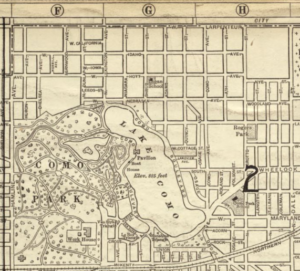Como Neighborhood History Project
 From apple orchards to parks & neighborhoods.
From apple orchards to parks & neighborhoods.
Committed to the power of place & change over time – It is a St. Paul cross roads.
Our oasis preserves rich land resources in service to and enjoyment for its residents & those afar.
The results – past & present recognition, a lively intersection with the state fair; commerce, residential care, nature, cemeteries, the Street Car line, and the border with Roseville, St. Paul’s first northern suburb.
District 10 – A community on the cusp of change for & seeking vision from its citizens.
Como Park History
- In 2009, Como resident Sharon Shinomiya created a self-guided historical tour of Como Park. You can walk or ride it yourself, using Sharon’s guide and a map designed by Darby Laing.
- Or, take the map and pop in your ear buds for an audio tour narrated by Greg Ritter (with help from Essential Sessions and Recording Edge Studios.)
- Several years later, Como resident Timothy Gadban compiled a chronological, rather than geographical, history of Como Park.
- For glimpses of events, pioneers, and characters who shaped Como Park and surrounding communities, see the archives of the late Roger Bergerson’s columns for the Park Bugle newspaper.
A Brief History Of Como
If you don’t have time for those detailed histories right now, here’s a two-minute version.
Swamps and oak savannas dominated the land where we now live. The land and its resources were utilized primarily by Dakota villagers, who are part of the Sioux people. The Dakota had trails through the area that gave them access to seasonal settlements, hunting grounds, maple stands, and lakes with wild rice. One 19th-century account says the Dakota called Lake Como “Medawaka” (which translates roughly into Lake Mysterious). Eventually, the Ojibwe (also known as Chippewa, and part of the Anishinaabe people) also established a presence, though the Ojibwe have a much stronger history in northern Minnesota. Treaties with the U.S. government in 1851 forced the Dakota to give up lands in what are now the Twin Cities.
Charles Perry was one of the earliest European settlers locally; he farmed a 160-acre claim of land that later would become Como Regional Park. The lake is named after a famous resort near Perry’s birthplace in the Swiss-Italian Alps.
Real estate developer Henry McKenty bought much of the land around the lake in the mid-1850s and had grand visions of fine resorts and villas along the shore. He built a road with his own money from central Saint Paul to the lake. (At that time, our neighborhood was far outside the city limits, in Rose Township.) Several hotels did operate near the lake in the late 19th century; several of them also burned down.
In 1873, Saint Paul purchased McKenty’s land. It wasn’t until the late 1880s, however, that economic conditions improved enough for the city to annex more land around Como Lake and to support development of what has become the landscape park envisioned by architect Horace W. S. Cleveland. In 1884, Cary I. Warren began developing Warrendale, southwest of the lake. Former lieutenant governor and real-estate developer Thomas Frankson bought farmland west of the park and, in the 1910s and 1920s, developed it into city lots. He lured potential customers with a bison park on Midway Parkway. It took until after World War II, however, for the residential areas of the neighborhood to fill in.
Industry and institutions began moving into the area much earlier. In the 1880s, St. Paul Foundry (later Maxon Steel) and John Martin Lumber opened east of Dale and south of Como. Crex Carpet Co. opened nearby in 1897. At what is now Bandana Square, the Northern Pacific Railroad had established its Como Shops in 1885. Koppers Coke operated south of the park between 1917 and 1979; it shut down instead of paying fines for violating federal air standards. The closing of Koppers (and the Como Shops a few years after that) allowed the development of Energy Park in the 1980s.
In 1885, the Minnesota State Fair moved to its current location. The Zoo started in 1897, then got a huge boost through WPA construction projects in the 1930s. Lyngblomsten opened in 1912. Bethel University opened a seminary and academy on Snelling Ave. in 1914, on the site now occupied by the Humphrey Job Corps Center. The Conservatory was completed in 1915.
The Como-Harriet streetcar line, which linked Saint Paul’s and Minneapolis’ most prominent lakes (and beyond), went into service in 1898, with trains as often as every three minutes. Interurban and local lines lasted until 1954. They ran along such neighborhood streets as Arlington, Chatsworth, Como, Dale, Front, Hamline, Horton, Maryland, Pascal, Snelling, and Van Slyke. Their legacy is evident in the Historic Streetcar Station, several bridges in the park, old rights-of-way if you know where to look, and the occasional rail that surfaces during road construction.
